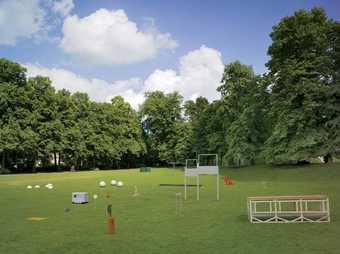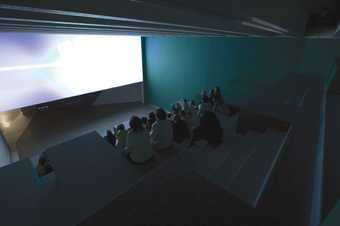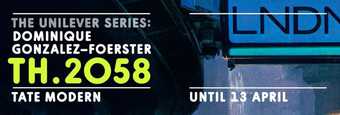The drive from Asturias Airport to León takes about two hours. The road follows the luxuriant green coast, full of eucalyptus trees, and then snakes inland. It climbs into the hills, past beeches and pines, and flattens out on a dry rocky plateau. The driver speaks no English; I, no Spanish. The continuity of the journey is broken only by the frequent tunnels, plunging us suddenly into dark shafts of concrete. Without conversation we turn in on ourselves. He corners the curves at 160 kph. I wonder about Dominique Gonzalez-Foerster’s exhibition and, on the return journey, about how to describe it. I had arrived at the airport in the rain and got out in León in the sun. The return was symmetrical: we left León in the rain and arrive at the airport in the sun. There is something about these journeys and, above all, the changing weather that seems to run in parallel with thinking about her work and accords nicely with Dominique’s interests, especially with her love of rain. Rain is something we hear as much as see. Each time we enter a tunnel the noise on the windscreen ceases abruptly, only to start up again as we regain the open air. The contrast between the tunnels’ nocturnal illumination and the sudden daylight is equally redolent of her vocabulary. Their architecture reminds me of her chosen structures: urban, monumental and just a little sinister. Or is it sublime? Something on a scale, and of a nature, that both attracts and repels.

Dominique Gonzalez-Foerster
Roman de Münster
Installation view at Skulptur Projekte Münster 2007
Photo: Roman Mensing
Courtesy Skulptur Projekte Münster 07 © Dominique Gonzalez-Foerster
Dominique Gonzalez-Foerster has been exhibiting for around two decades. Ever since she was a student at the art school and Le Magasin in Grenoble, she has enjoyed working with others, including Jean-Luc Vilmouth and Ange Leccia, not least because she is fundamentally sceptical about the notion of original authorship. In Grenoble she met artists, such as Philippe Parreno, who have continued to work with her. At the beginning of the 1990s she began to use lighting, along with a bare minimum of accessories – most often chairs and a table – to create rooms with a particular and specific atmosphere. By the end of the decade she had added the themes that have been central to her work to date: Brazil (in particular) – she lives there for several months a year – and tropicalisation (more generally). This has meant that her earlier interest in the forms of modernism has taken on a more personal inflection, as she navigates modernisms outside Europe, be it São Paulo, Los Angeles or Taipei. Exploring an established topos – the greater amplitude extended to Corbusian modernism by the climate, materials and temperament of the tropics – she has individualised it with the addition of her repertory of special effects: sound and light give us weather and atmosphere. Her profound sense of place is also a sense of disorientation – her visitors resemble tourists who have lost their bearings and all real sense of time.
In 2002 Dominique Gonzalez-Foerster showed in the gardens of the Orangerie in Kassel, in documenta 11. Her installation was effectively a conglomeration of accessories from the diverse places with which she is familiar. Their semi-functional aspect – they included a light, a bench and a phone booth – made their presence low-key, but all the more intriguing. Like a cast of characters in search of an author, or an actor, they were assembled at polite distances from each other on the lawn and yet together created a strong sense of place.
In most recent years her work has been more discreetly encountered in the retail interior (she has been designing the interiors of Balenciaga) and on the lawns of Münster, where her contribution, entitled Roman de Münster, recaptured past exhibits by herding them together and on a smaller scale. It heralds rather nicely her plans for Tate Modern, where altered scale will play an important role.
The next day, while waiting for the opening of Gonzalez-Foerster’s show at the Museo de Arte Contemporáneo de Castilla y León (MUSAC), a new museum of contemporary art, I spent my time looking at the town of León. It has a French-style Gothic cathedral with a cloister with intricately carved pendentives and spiralling stone turrets. Nearby is the Basilica de San Isidoro, with the pantheon of the early Castillian kings, dating from the twelfth century. Above its thirteen tombs, the pantheon has a wonderfully painted ceiling, with images of the different months of the year and representations of the Evangelists. Upstairs, the seventeenth-century library has an exquisitely worked white and blue painted ceiling. The whole medieval fabric is dedicated to the after-life, the signs of the supernatural, the focus on heaven and hell. Everywhere one’s eye is compelled upwards. This backdrop stayed in my mind as I visited Gonzalez-Foerster’s exhibition.
MUSAC is built on a modern urban scale with few concessions to architectural niceties, which fitted in with Gonzalez-Foerster’s interests in urbanism. She was able to stage her successive rooms at a pace which matched their ambitions. Promenade (where you could hear the sound of tropical rainfall) gave way to Tapis de Lecture (the piles of books that are source material for her fictions) and then to Panorama. The final stop – and the new work which gave its name to the show as a whole – was Nocturama, where the bewildered visitor could find his or her way on to a platform which permitted a view of a changing spectacle reminiscent of the Northern Lights. One had to look up to see anything, and one had to be patient before the lights appeared, slowly changing shape and intensity. More than an artwork, this reminded the viewer of looking for natural phenomena, and of the signs in the heavens. The cavernous spaces of MUSAC were unheated. Crossing a small internal patio dotted with red plastic chairs, one entered the first space. Nothing was present, other than the sound of rain. The solarium was sunless; though a spectacle of changing lights was visible on the screen. On the rug, piles of books transparently set out the artist’s bibliography, in all available languages. In the cinema, more red picnic chairs were randomly arranged in front of the films, which were largely set on rivers or in rainy parks. After being progressively chilled in the solarium, the cinema and the nocturama, I headed back to the first room, where the rain drilled ceaselessly. I saw women crossing the patio with umbrellas and assumed they had been fooled by the soundtrack. But no, it really was raining. I left by running across the patio, picking my way round the gathering puddles and through the red chairs.
The exhibition was inaugurated with a lecture by the Spanish novelist Enrique Vila-Matas, who cited several novelists important to Gonzalez-Foerster (who can be found on her Tapis de Lecture), including Adolfo Bioy Casares and Roberto Bolaño. Vila-Matas’s lecture reminded me of Bolaño’s stories, which are always about writers meeting (or not meeting) other writers, admiring them, envying them, watching them, becoming obsessed by them. He talked of the unavoidability of plagiarising and paraphrasing others, and amused his audience by giving examples in which his own invented quotations for other authors had since been used as if they were authentic. Georges Perec’s Life: A User’s Manual had long been a key text for the author, in a tradition that went back to Laurence Sterne, the latter an important author for both Vila-Matas and Gonzalez-Foerster.
This weekend I visited Shandy Hall, in North Yorkshire, where Sterne wrote the majority of Tristram Shandy. Our guide, its custodian and its inhabitant, showed us round a nicely proportioned building of different vintages. Its exhibits had all been accumulated since Sterne lived there; so there was little if any authenticity remaining. The custodian, a writer himself, saw all this as part of the meaning of the house, and in the tradition of Sterne: without chronological or narrative beginning or middle or end, we will put our story together and mix up history in our own ways, reading its different material evidence to suit our own concerns.
How do we inhabit old buildings? How do we imagine their future? Are we part of that future, and how will the passage of time affect the things that buildings house? In imagining the future of the Turbine Hall – and joining things to come with the things that were – Gonzalez-Foerster will put to the test her sensitivity to the meaning of space, its reality and its potentiality. Here, in a turbine hall, she will consider the relationship of London under threat with the treasures that endure. Like some kind of ancient tomb, where goods are stored to await new life, Gonzalez-Foerster will confront Giles Gilbert Scott’s structure with its past and its present.


